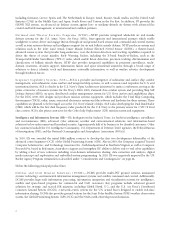Raytheon 2010 Annual Report Download - page 20
Download and view the complete annual report
Please find page 20 of the 2010 Raytheon annual report below. You can navigate through the pages in the report by either clicking on the pages listed below, or by using the keyword search tool below to find specific information within the annual report.position in the market. In certain instances, we have augmented our technology base by licensing the proprietary
intellectual property of others. We also license our intellectual property to others. While our intellectual property rights
in the aggregate are important to the operation of Raytheon, we do not believe that any existing patent, license or other
intellectual property right is of such importance that its loss or termination would have a material adverse effect on our
business, taken as a whole.
Employment
As of December 31, 2010, we had approximately 72,000 employees. Approximately 8% of our employees are unionized.
We consider our union-management relationships to be generally satisfactory.
Environmental Regulation
Our operations are subject to and affected by a variety of international, federal, state and local environmental protection
laws and regulations. We have provided for the estimated cost to complete remediation where we have determined that it
is probable that we will incur such costs in the future to address the environmental impact at current or formerly owned
operating facilities or at sites where we have been named a Potentially Responsible Party (PRP) by the Environmental
Protection Agency (EPA) or similarly designated by other environmental agencies. It is difficult to estimate the timing
and ultimate amount of environmental cleanup costs to be incurred in the future due to the uncertainties regarding the
extent of the required cleanup, the discovery and application of innovative remediation technologies, and the status of the
law, regulations and their interpretations.
In order to assess the potential impact on our consolidated financial statements, we estimate the possible remediation
costs that we could reasonably incur. Such estimates take into consideration the professional judgment of our
environmental professionals and, in most cases, consultations with outside environmental specialists.
If we are ultimately found to have liability at those sites where we have been designated a PRP, we expect that the actual
costs of remediation will be shared with other liable PRPs. Generally, PRPs that are ultimately determined to be
responsible parties are strictly liable for site clean-up and usually agree among themselves to share, on an allocated basis,
the costs and expenses for investigation and remediation of hazardous materials. Under existing environmental laws,
however, responsible parties are, in most circumstances and jurisdictions, jointly and severally liable and, therefore,
potentially liable for the full cost of funding such remediation. In the unlikely event that we are required to fund the
entire cost of such remediation, the statutory framework provides that we may pursue rights of contribution from the
other PRPs. The amounts we record do not reflect the unlikely event that we would be required to fund the entire cost of
such remediation, nor do they reflect the possibility that we may recover some of these environmental costs from
insurance policies or from other PRPs, because neither manner of recovery is deemed probable. However, a portion of
these costs are eligible for future recovery through the pricing of our products and services to the U.S. Government.
We manage various government-owned facilities on behalf of the U.S. Government. At such facilities, environmental
compliance and remediation costs have historically been primarily the responsibility of the government and we relied
(and continue to rely with respect to past practices) upon government funding to pay such costs. While the government
remains responsible for capital and operating costs associated with environmental compliance, responsibility for fines
and penalties associated with environmental noncompliance are typically borne by either the government or the
contractor, depending on the contract and the relevant facts. Fines and penalties are unallowable costs under the
contracts pursuant to which such facilities are managed.
Most of the laws governing environmental matters include criminal provisions. If we were convicted of a criminal
violation of certain federal environmental statutes, including the Federal Clean Air Act and the Clean Water Act, the
facility or facilities involved in the violation would be placed by the EPA on the “Excluded Parties List” maintained by the
Government Services Administration. The listing would continue until the EPA concluded that the cause of the violation
had been cured. Listed facilities cannot be used in performing any U.S. Government contract awarded during any period
of listing by the EPA.
Additional information regarding the effect of compliance with environmental protection requirements and the
resolution of environmental claims against Raytheon and its operations is contained in Item 1A “Risk Factors,” Item 3
12
























